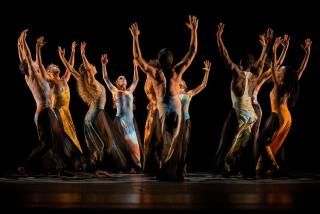DANCE REVIEW : A New Spin on Graham : Twyla Tharp Adds Her Touch
- Share via
Feminist modern dance based on Greek myth: Isn’t that exactly what you’d expect from the Martha Graham company?
Perhaps, but you might have been surprised by at least one of the company’s Greek dance-dramas Thursday at the Cerritos Center for the Performing Arts.
In an amazing career that ended with her death three years ago, Graham created a repertory of masterworks that radically reinterpreted ancient Greek legends--and her “Errand Into the Maze” provided a potent example on the four-part Thursday program. No surprise here.
To music by Gian Carlo Menotti, this 1947 duet changed the story of Ariadne and the Minotaur into a study of a woman consumed by fear and then heroically conquering it.
But while female heroism also dominated “Demeter and Persephone” on the same program, this Greek dance-drama proved the last thing you’d expect to find in the Graham repertory because it wasn’t by Graham at all. For the first time in its history, the company commissioned a work by an outsider and the choice fell on the predictably unpredictable Twyla Tharp.
Tharp, of course, started out as a dancer with Paul Taylor, who started out with Graham--so she belongs to Graham’s extended family. But even though “Demeter and Persephone” accommodated the Graham legacy by adopting a narrative structure--and including a Grahamesque diva role--this 1993 creation remained indomitably Tharpian in its emphasis on speed, sequencing ploys and, most of all, perhaps, its audacious choice of accompaniment.
Consider the clash of sensibilities Tharp set in motion: Demeter was the ancient Greek goddess of agriculture whose search for her abducted daughter eventually divided the year into the seasons as we know them. Christine Dakin portrayed her with sorrowful grandeur as the archetypal grieving mother. But Tharp’s score consisted of irresistibly raucous, sinuous Klezmer recordings and the rich, silver-over-black costumes by longtime Tharp collaborator Santo Loquasto added deliberate Eastern European folk accents of their own.
The result proved a very mixed metaphor, though you could easily see how the quasi-Yiddish overtones here reflected the same pan-cultural concept as the unmistakably Japanese accent in Isamu Noguchi’s now-classic settings for Graham’s Greek dance-dramas. Graham and Tharp recognized that the Greek myths are universal: You can set them anywhere. Tharp may have chosen a novel frame of reference, but she understood Graham’s own audacity.
Unfortunately, Tharp’s storytelling skills turned out to be feeble, with all her frantic rocking-the-baby gestures and other spasms of gesticulation looking clumsy on their own and absolutely hopeless compared to Graham’s gestural eloquence elsewhere on the program.
What Tharp ultimately offered the Graham dancers wasn’t a deep probing of ancient legend but rather a thrilling display of contemporary technique.
Her best sequences bypassed character and narrative to harness the dynamism of the 10-member cast in surging, formal Klezmer cadenzas. And when that happened, she made you very, very happy. Besides dancing Tharp’s earth mother, Dakin became the Bride in Graham’s familiar “Appalachian Spring” (1944, music by Copland), simplifying the character’s inner conflicts but keeping the movement strongly defined. Donlin Foreman was her powerful, sympathetic partner and Denise Vale a rather lightweight, blandly cheery pioneer woman.
Opposite these uniformly likable characterizations, Pascal Rioult all but stole the performance as a lumpen , grotesquely tormented preacher: as twisted and devious as his counterpart in Paul Taylor’s “Speaking in Tongues.” Equally individual, Terese Capucilli’s dancing in “Errand Into the Maze” heightened the feminism of the work by showing how the woman’s fears empowered the male threat personified by Mario Camacho. Indeed, he scarcely seemed to exist except in her mind.
Created in 1936 to music by Wallinford Riegger), “Steps in the Street” represented only a brief fragment of a lost suite titled “Chronicle.” But Graham’s bold movement design for a central figure (Vale) and woman’s corps demonstrated an inspired fusion of rhythmic, sculptural and processional imagination placed at the service of an uncompromising social vision.
More to Read
The biggest entertainment stories
Get our big stories about Hollywood, film, television, music, arts, culture and more right in your inbox as soon as they publish.
You may occasionally receive promotional content from the Los Angeles Times.










